ADDRESS AT THE INAUGURATION OF THE SECOND INTERNATIONAL CONFERENCE-CUM-EXHIBITION ?INDIA R&D 2006: MIND MARKET?
04-12-2006 : New Delhi
Towards World Knowledge Platform
?Knowledge connectivities enrich nations?
I am delighted to participate in the inauguration of the Second International Conference-cum-Exhibition ?India R & D 2006: Mind Market?. I greet the organizers, researchers, scientists, technologists, education planners, industry captains and other distinguished participants of the Conference. I am happy to know that based on the discussions in the 2005 Conference, four centers of excellence are likely to be established in India in the areas of biomedical technologies, lasers & accelerators, non-ferrous metallurgy and seismology as Indo-Russian collaborative projects.
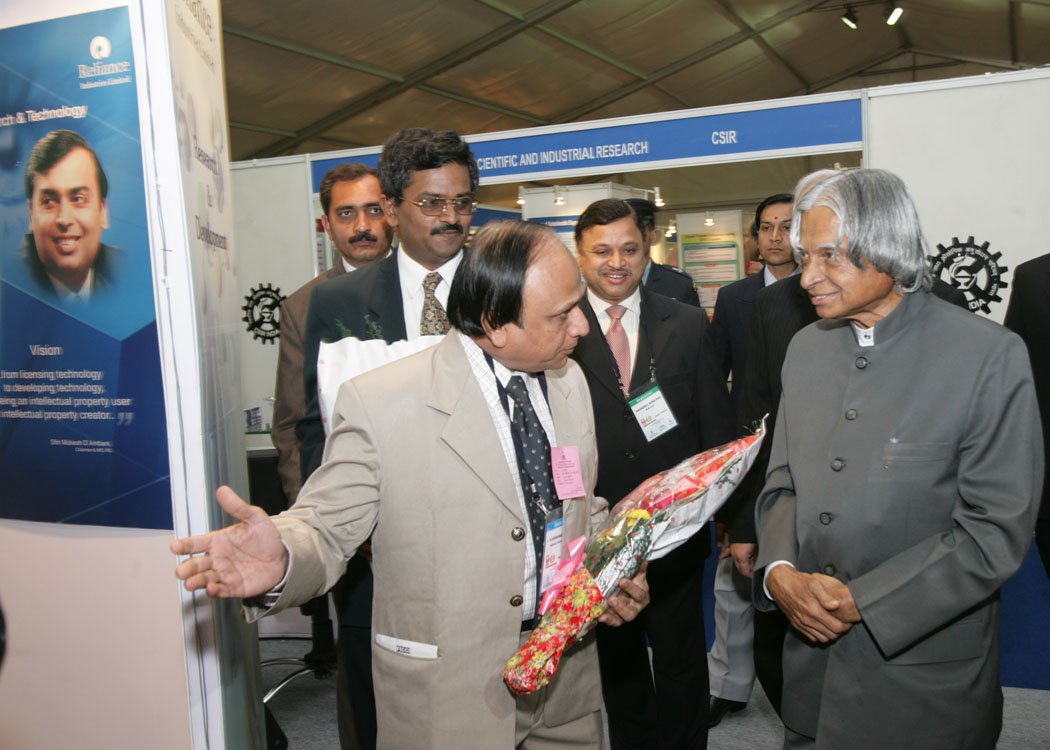
Since the seminar is being attended by scientists, technologists, academicians, researchers, industrialists, bankers and venture capitalists from India and abroad and policy makers from Central and State Governments, I would like to share with you a possible launch pad through which we can have partnership missions beneficial to the world community.
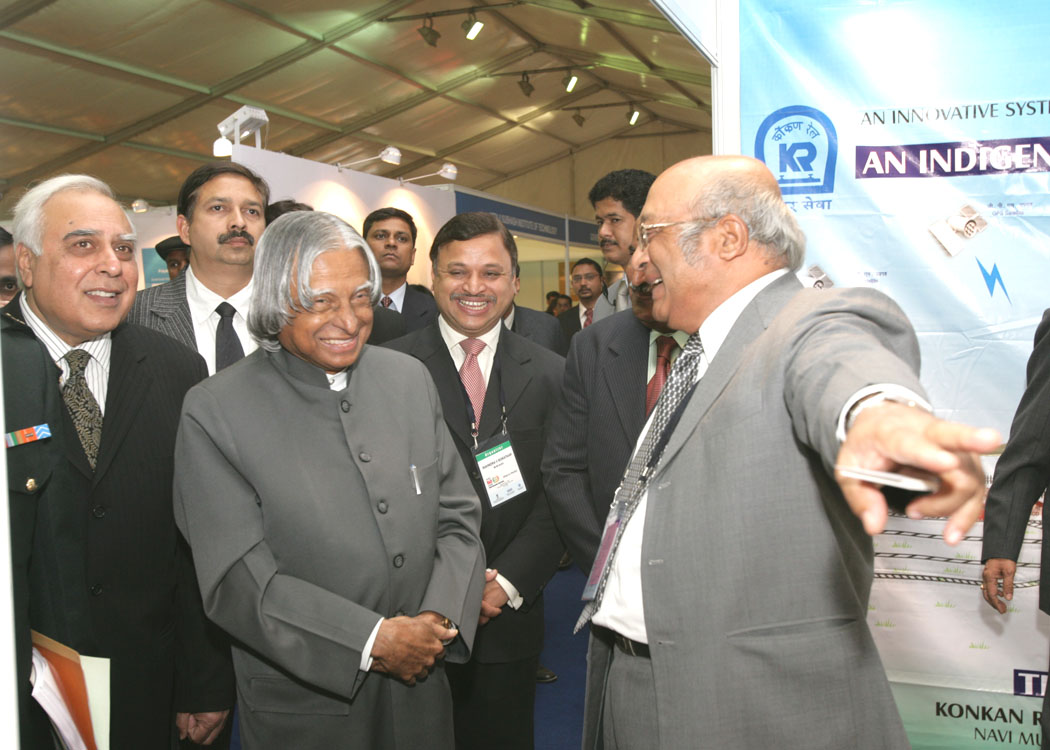

World Knowledge Platform
During my visit to Singapore, Philippines and Republic of Korea early this year, I have put forward a framework called ?World Knowledge Platform?, which will integrate the core competencies of the partner countries to develop knowledge products. This platform will enable joint design, development, cost effective production and marketing of the knowledge products in various domains based on the core competence of partner nations to international market.
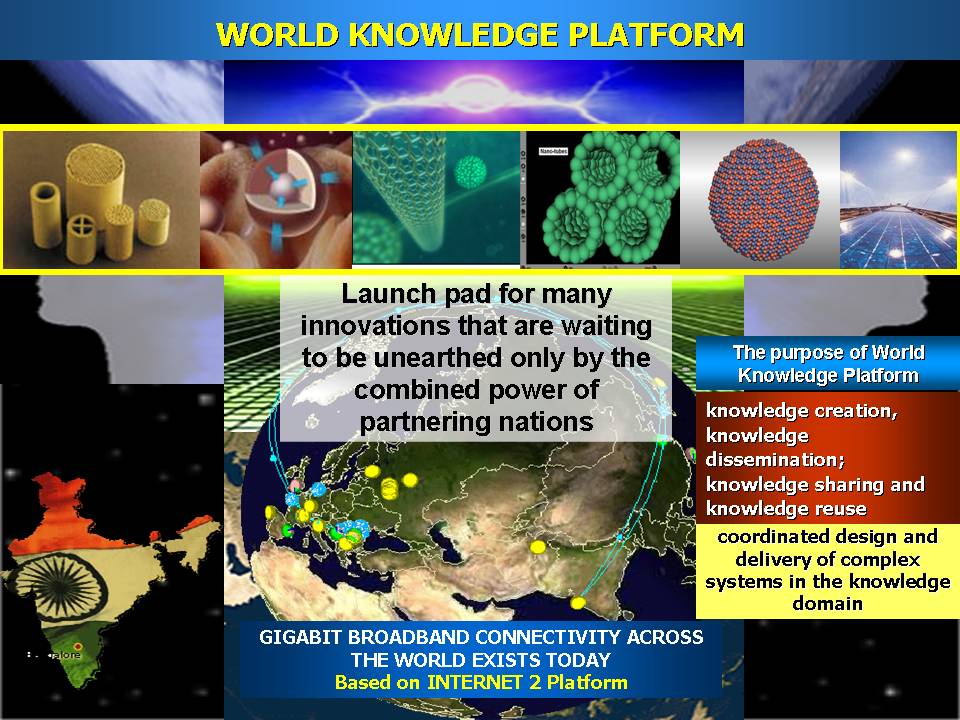
Initially, the mission of World Knowledge Platform is to connect and network the R&D Institutions, Universities and Industries using fiber broadband from the partner nations on selected R&D Missions. The underground fiber cable infrastructure already exists between many partners. For example, from Rashtrapati Bhavan Multimedia studio, I had a high definition multimedia teleconferencing using high
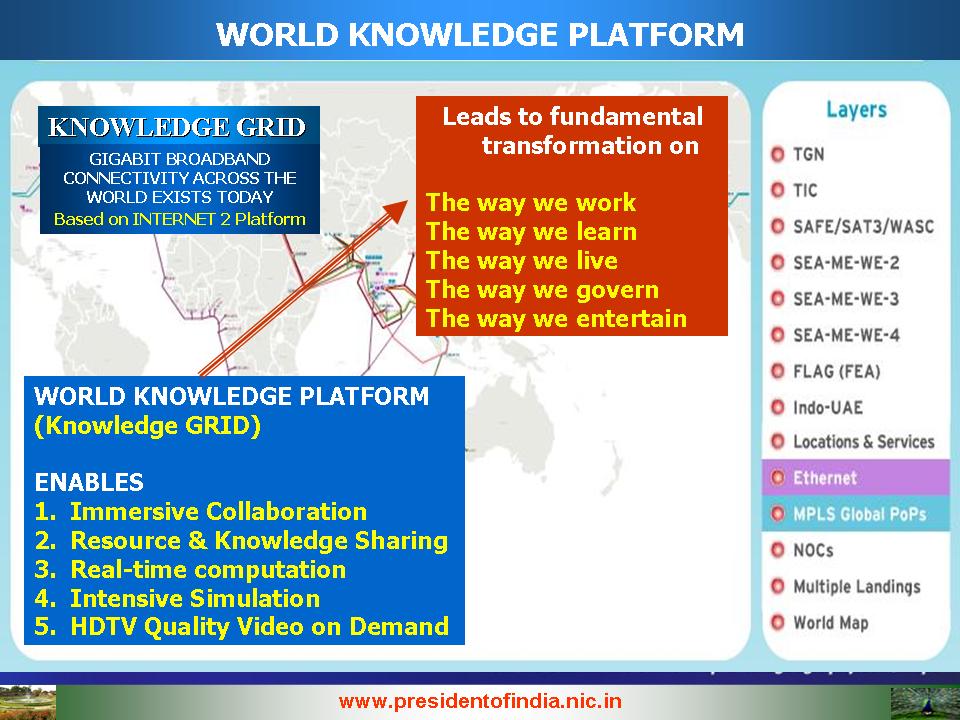
bandwidth end-to-end fiber optics connectivity with University of California, Santiago, to address the US-India Summit on Education, Research and Technology. Similarly I had addressed the multiple gathering in Johannesburg, South Africa, Durban, San Francisco, USA while delivering the Philip V Tobias Lecture with live interaction. Recently I have addressed a Symposium on Nalanda: Buddhist Cultural links between Eastern and Southern Asia, Singapore on the topic ?Evolution of Enlightened Citizens in the planet Earth?. (Refer: ). This experience gives me the confidence that fiber optics connectivity across the world is only waiting to be lighted up, which will make the world
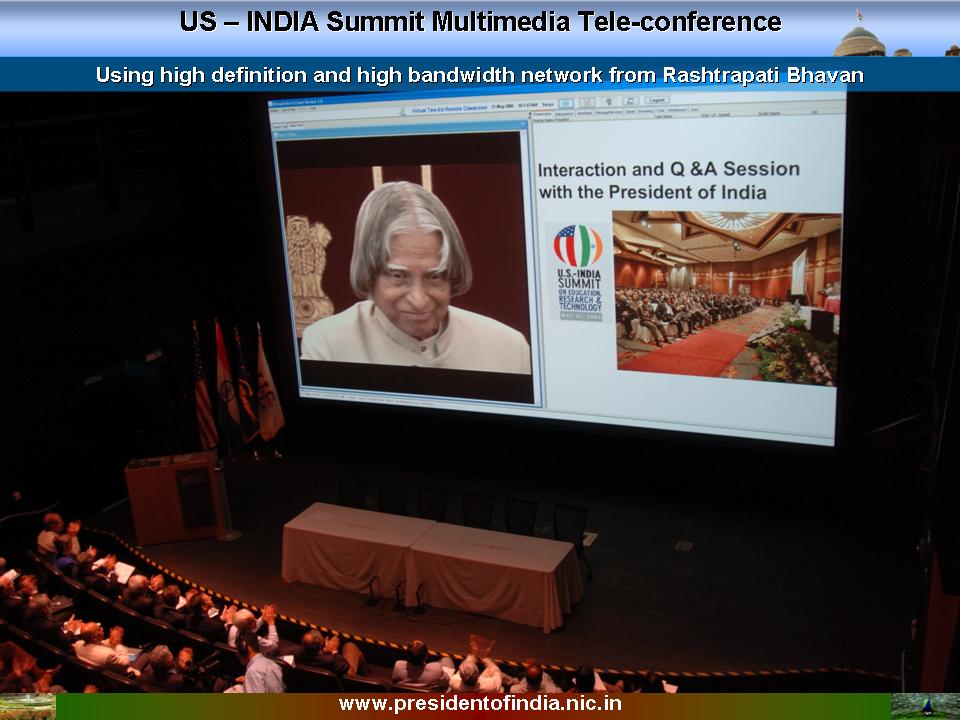
borderless. This knowledge GRID will support multitude of seamless connections supporting both synchronous and asynchronous communication, carrying either text or audio or video. We can then use this network in the academic environments to teach courses online and share expensive equipments remotely. In the Industrial environment, it can be used to design complex systems ? even ones that are as complex as an aircraft in a collaborative way using virtual
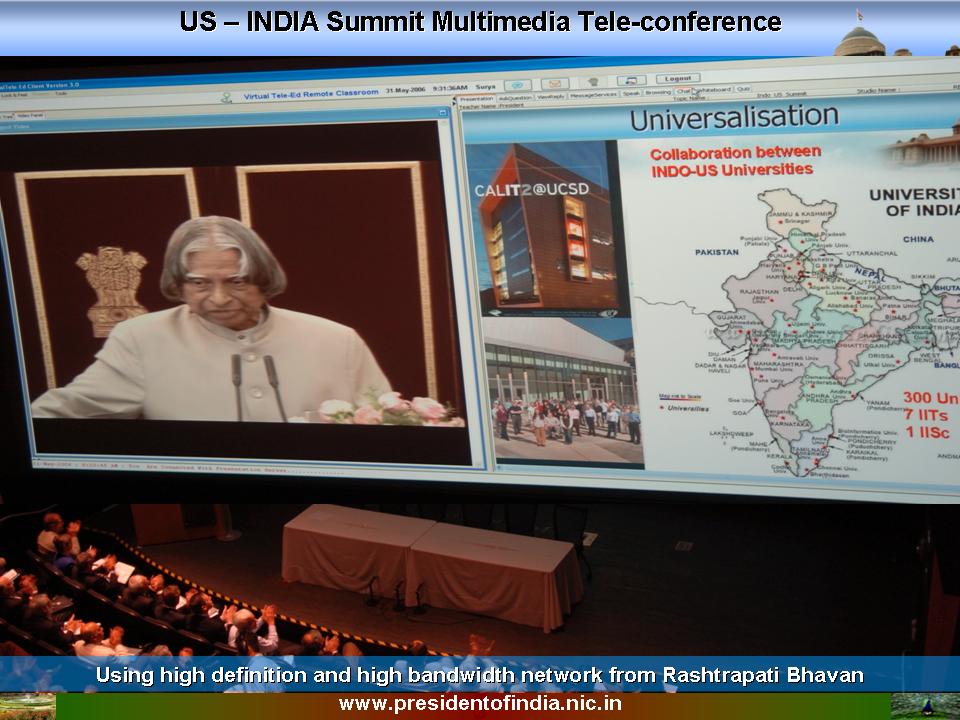
prototyping concepts in the cyber space. The proposed world knowledge platform has been derived based on the success story of developing, leading to production and marketing of a state-of-the-art super sonic cruise missile system through a partnership between two countries.
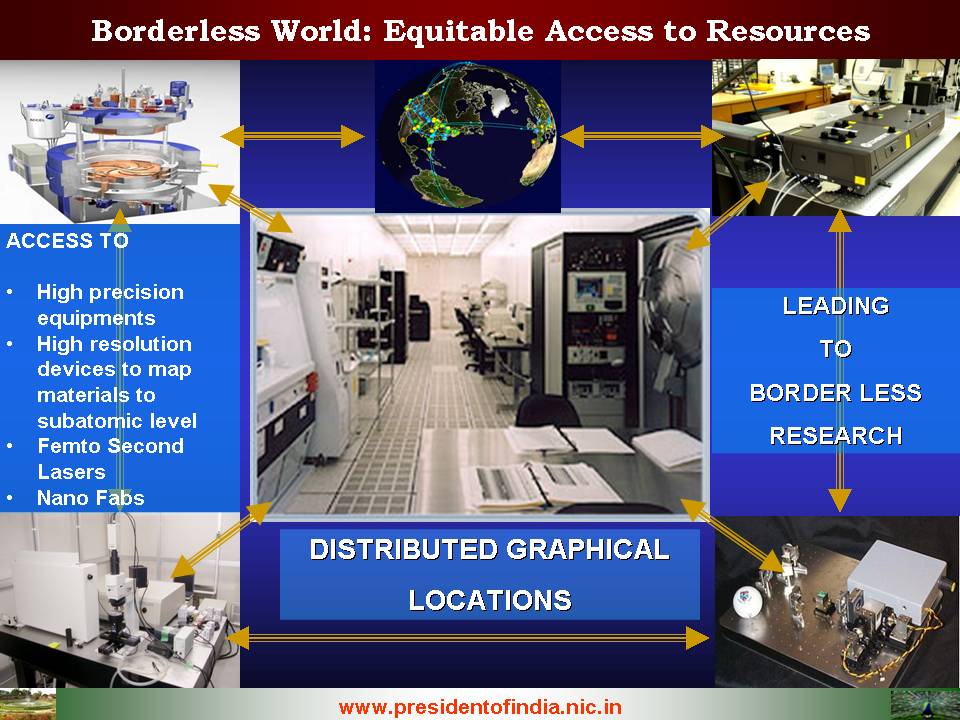

An International Joint Venture ? BRAHMOS
I would like to share a unique experience of design, development, production and marketing of a missile system - BRAHMOS, an Indo-Russian joint venture. What we have achieved through this venture is the development and realization of a world-class product using the synergy of technological competence and consortium of industries of partner countries. In addition, the product being internationally competitive is able to service a large market with availability in time and state of the art performance at reduced cost per unit. This will put the partner countries in the global market. Moreover, with minimum incremental investment the product has been developed and led to production and induction, at a relatively short time frame, well ahead of prescribed schedule. This has enabled early entry of the product into the world market well before any competitor could emerge.
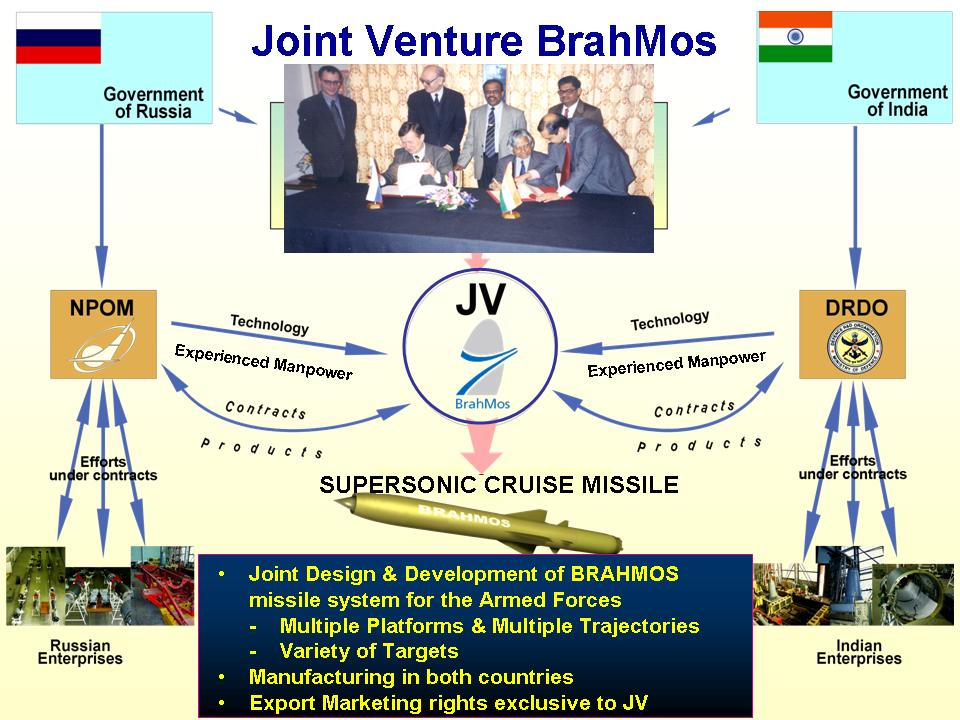
We have to emulate these examples to create products and systems for civilian application both in the national and international markets. At this stage, this is very important because the middle-class population in India is on the growth path and it will reach nearly 400 million within next three years. This will lead to a win-win situation for partner countries and enable availability of products at a low cost for the customer countries leading to nations? wealth generation. The creation of world knowledge platform will enable promotion of partnership between nations for synergising the core competence of multiple nations.
Missions of World Knowledge Platform: The ?World Knowledge Platform? will take up the missions, in some of the areas given below, which are of utmost urgency to all of us to make our world a safe, sustainable and peaceful and prosperous place to live:
1. Energy: exploration, storage, production and conversion
2. Water: treatment, sustainable use, efficiency in use and minimal utilization for maximum use, desalination
3. Healthcare: Diagnosis, drug delivery system, life long care. Gene Characterization, Stem Cell research and molecule to drug towards the diagnostic and treatment of the diseases like Cancer and Diabetics.
4. Agriculture and Food: Production, preservation, processing, storage and distribution
5. Knowledge products: Hardware, Software and Networking Products and user interfaces.
6. Automobile: Hardware and embedded software integration, assistance in transport system through GPS.
7. Traditional medicine: Herbal and natural products, sharing experiences with modern bio products.
I would like to focus on Energy, Agriculture, Food processing and Knowledge Products that has got challenges in research, production and world wide marketing.

Energy Independence
I am presenting to this conference the concept of Energy Independence which will enable us to combat the challenges of continuous depletion of fossil fuels in the globe, environmental protection and availability at an affordable cost. Our target is to achieve Energy Security by 2020 leading to Energy Independence by 2030 and beyond. What are the challenges?
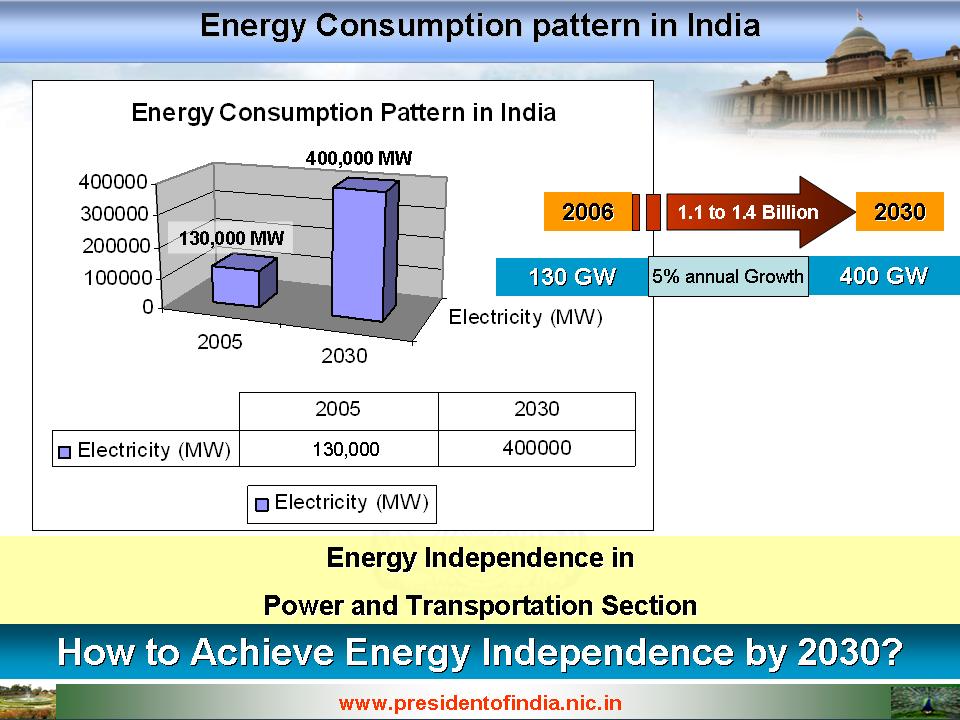

Structure of Energy Sources for India
Based on the progress visualized for the nation during the next two decades and economies and savings planned to be achieved, the power generating capacity has to increase to 400,000 MW by 2030 from the existing hundred and thirty thousand Megawatts in India. Energy independence has got to be achieved through three different sources namely hydel capacity, nuclear power and non-conventional energy sources primarily through solar and wind energy, apart from thermal power through clean coal technology. The Hydel capacity is
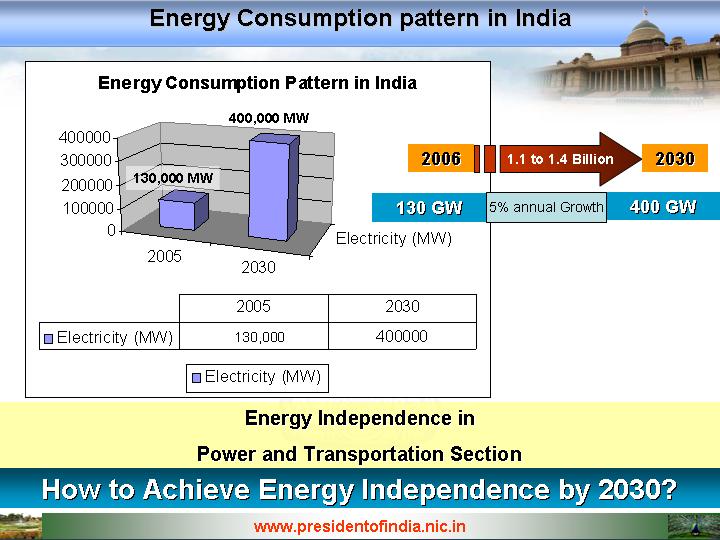
expected to contribute an additional 50,000 MW. Large scale solar energy farms of hundreds of megawatts capacity in certain number could contribute around 55,000 MW and wind energy can contribute 64,000 MW. The nuclear power plants should have a target of 50,000 MW of power. The balance 51,000 MW has to be generated through the conventional thermal plants using clean coal technologies. Let me discuss about the profile of renewable energy systems.
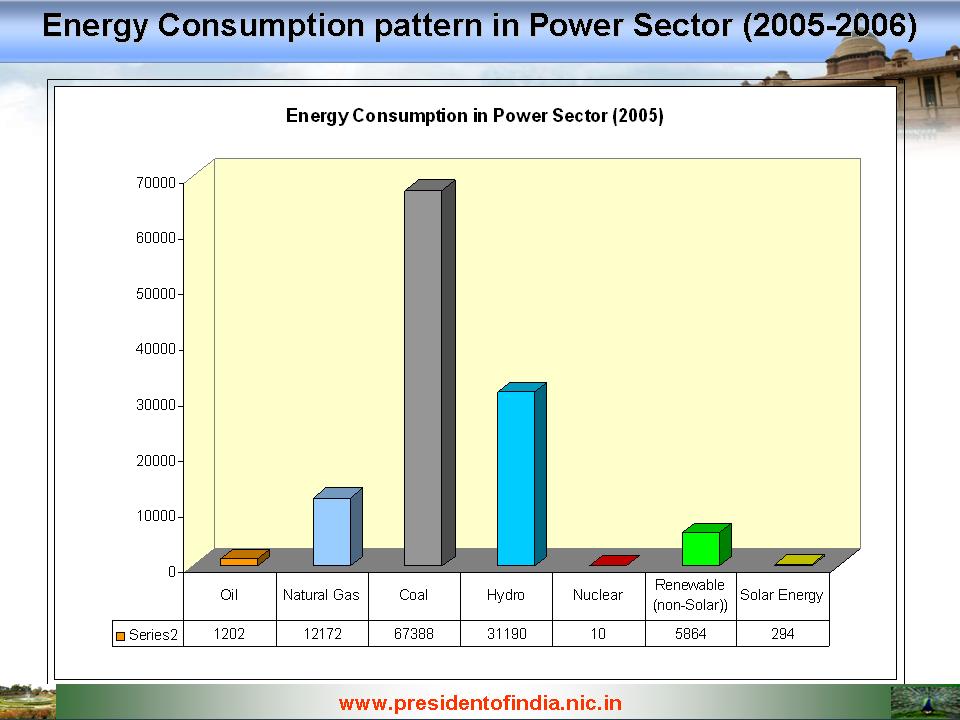
The energy mix for energy independence envisages use of four routes: (a) Hydel + Thermal till coal availability (b) Solar power using high efficiency CNT based SPV cells and wind energy (c) Thorium based nuclear reactors (d) Bio-fuel for transportation sector.
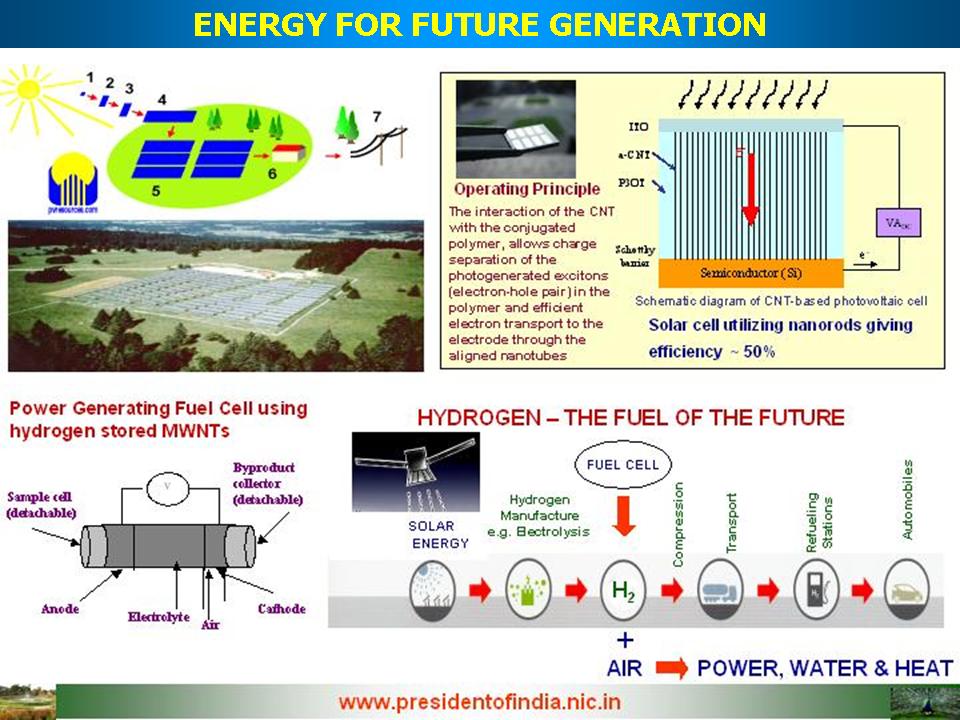
Carbon Nano Tube (CNT) based solar cells for higher efficiency: The low efficiency of conventional Photo Voltaic (PV) cells has restricted the use of solar cells, for large power generation application. Research has shown that the Gallium Arsenide (GaAs) based PV cell with multi junction device could give maximum efficiency of less than 30%. Hence it is essential to launch a research mission on Carbon Nano Tube (CNT) based PV cell which has the potential for higher level of efficiency.
Recent research has shown that the alignment of the CNT with the polymer composites substrate is the key issue and this aligned CNT based PV cells would give very high efficiency in photovoltaic conversion. In this process, the researchers could achieve the efficiency of about 50% at the laboratory scale. Our scientists from India and partner countries have to take up this challenge and come up with the development of a CNT based PV cell with an efficiency of at least 50% within the next three years so that it can go into commercial production within five years. Solar power generation using high efficiency CNT based solar power photovoltaic cells will be highly competitive, compared to other forms of energy generation systems.
In addition, we should work on solar thermal power plants which use the thermal energy produced by the sun to generate electricity. They consist of three main components: mirrors, receivers and turbine technology. Technology is available and large scale power plants will be in position by 2007. Let me now discuss with you on the power generation through nuclear energy.
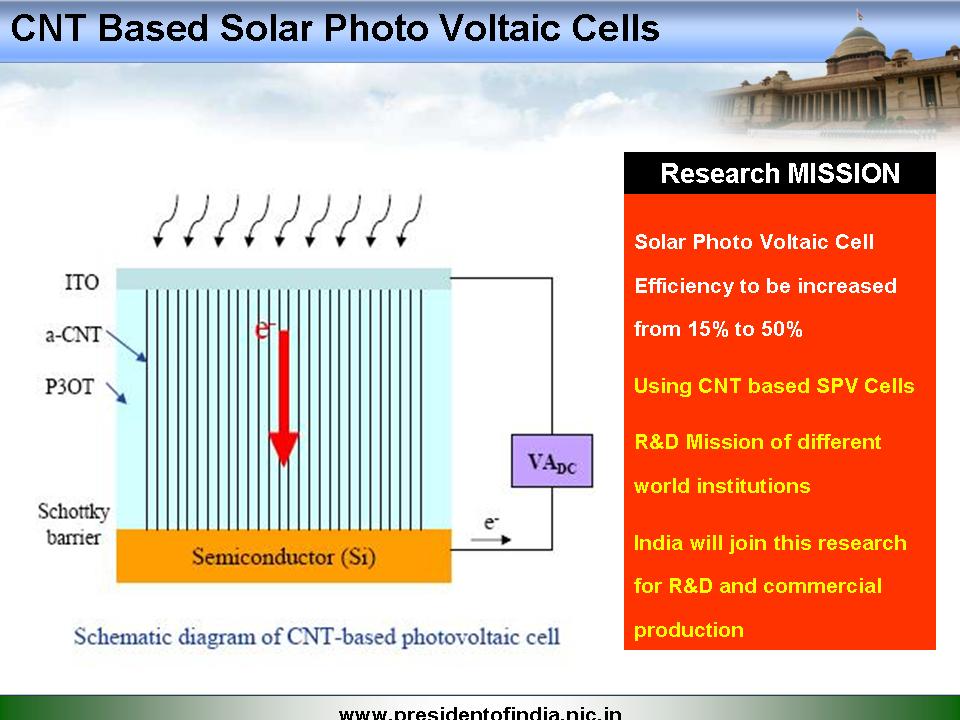

Nuclear Energy
So far, the present nuclear power capacity of 14 reactors which is 3900 MW is expected to go to 7400 MW by 2010 with the completion of nine reactors which are now in progress. Eventually as per present plan of BARC and Nuclear Power Corporation the capacity by 2020 is expected to be increased to 24,000 MW. There is a need to plan right from now to increase this capacity to 50,000 MW by 2030.
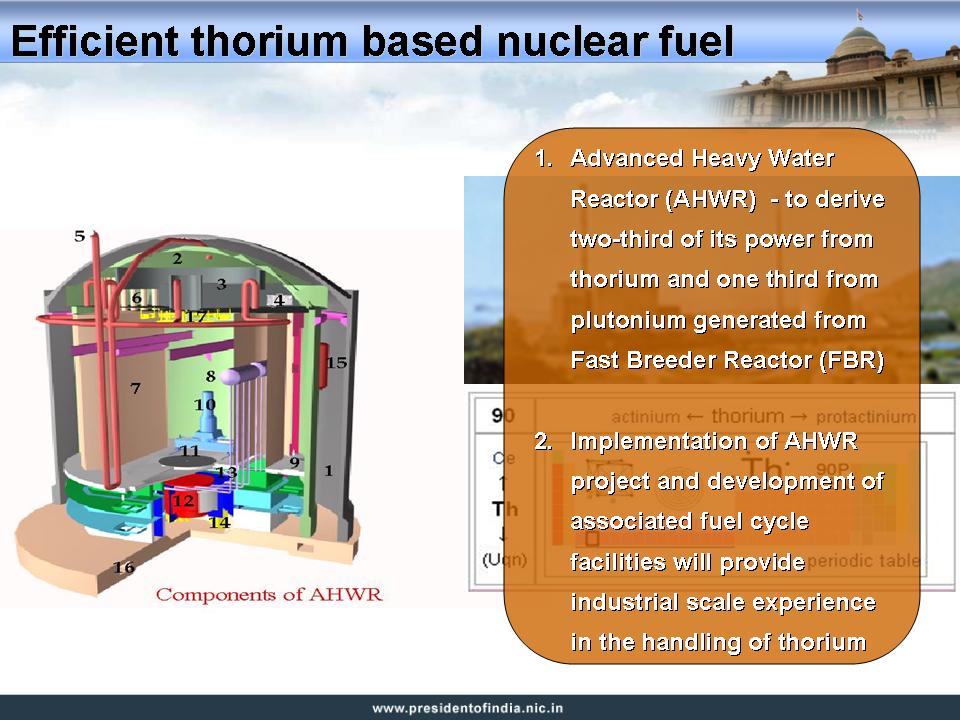
Nuclear power generation has been given a thrust by the use of uranium based fuel. However to meet the increased needs of nuclear power generation, it is essential to pursue the development of nuclear power using Thorium, reserves of which are higher in the country. Technology development is being accelerated for Thorium based power plants. Now let me share with you the power generation through wind energy and its potential.
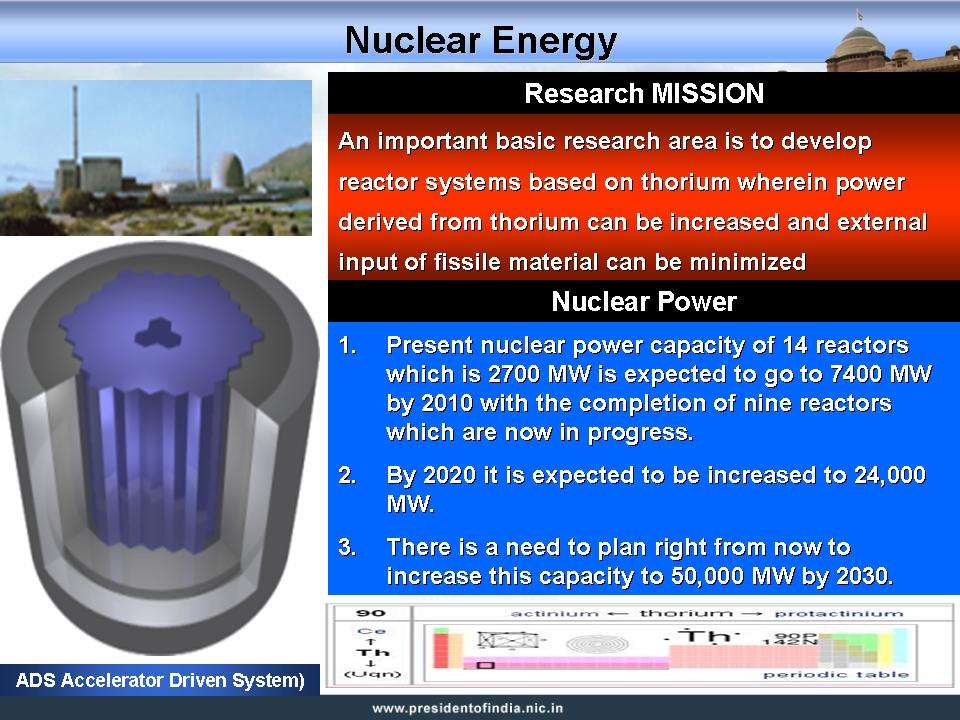

Indian Scenario in Wind Power
Presently, with a total installed capacity of 7000 MW India is the 4th largest producer of wind energy, the first three being Germany, Spain, United States. Today, we have an estimated potential of 45000 MW which itself should be capable of being reviewed upward on account of fast improving technologies and scientific advancements and use of coastal area for augmentation. Based on the growth prospectus, we have a vision of generating 64,000 MW of electric power from wind energy.
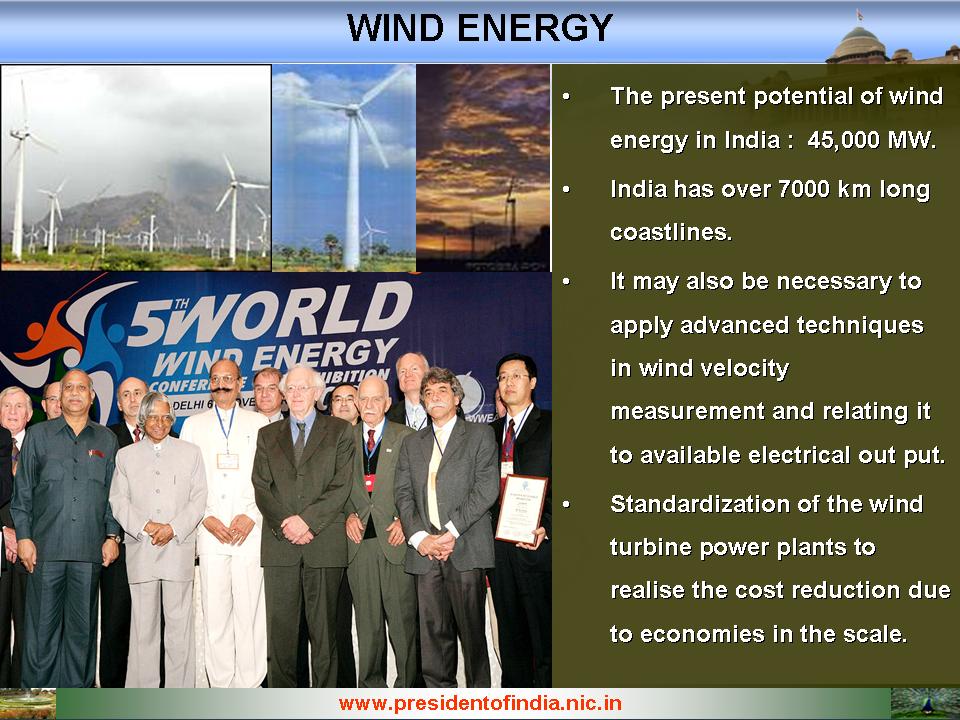
Suggestions: For realizing the above vision, I have suggested the following actions during the 5th World Wind Energy conference, New Delhi, which I would like to share with you:
A. The present potential of wind energy in India has been worked out to be 45,000 MW. Studies must be launched to explore other potential sources such as off-shore wind farms, especially, since India has over 7000 km long coastlines. It may also be necessary to apply advanced techniques in wind velocity measurement and relating it to available electrical out put.
B. Work towards standardization of the wind turbine power plants to realise the cost reduction due to economies in the scale. Also research and development is required for reducing the investment per MW through improved designs and application of newer technologies.
C. I understand that the generation cost at presently is between Rs.2.5 to Rs.3.5 per unit depending upon the site. Research is required to bring down this cost to Rs.1.00 to Rs.2.00 per unit based on improved designs and maintenance free systems.
D. In islands and remote areas autonomous wind generating units should be established if the site has the wind potential. This task must be completed within the next 3 years as a public private partnership action.
E. Feasibility studies may be conducted to determine economic sizes of wind energy plants which can be used for lifting water from 30 meter level and serve the needs of farmer having small holdings in a region with an average wind speed of 8 to 10 km per hour.
As the transportation sector in India consumes about 90% of the total available oil, I would now like to discuss the possible energy policy in this sector.

Energy in Transportation Sector
The Transportation sector in India is the fastest growing energy consumer. We import nearly $ 30 billion of oil annually and are critically important for Indian economy and security. Our indigenous oil production meets only 25% of our total requirement. Hence, there is an urgent need to find alternative fuels and energy sources. One of the promising areas for the country is production of bio-fuels.
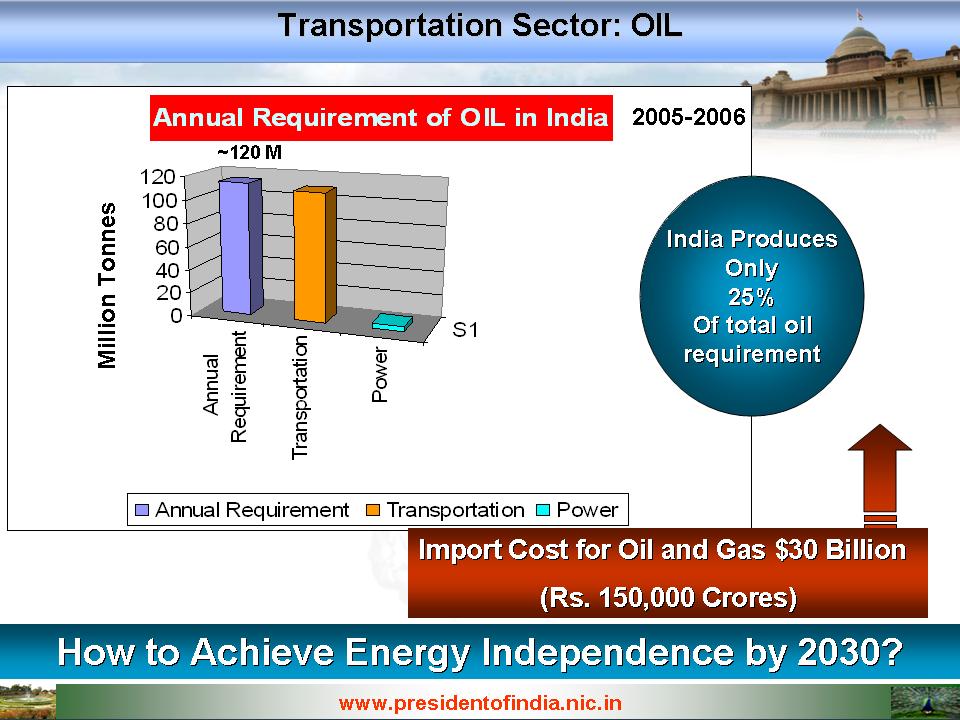
Use of Biofuel: Recently, we had a Bio-diesel Conference towards Energy Independence in Rashtrapati Nilayam, Hyderabad on 9th and 10th June 2006, where all the stakeholders (farmers, entrepreneurs, marketing agencies, researchers, policy makers and NGOs) actively participated. The conference suggested the following mission mode actions.
(i) Realizing the production of 60 million tonnes of bio-diesel per annum by 2030 (this would be 20% of anticipated oil consumption in 2030).
(ii) As a first step towards reaching this target, a coordinated plan for achieving 6 million tonnes production by 2010 which would be 5% of the present import of oil.
(iii) To improve through research, the productivity of seed and extraction techniques and expand the area under bio-diesel crops towards achieving 30 million tonnes oil by 2020 and 60 million tonnes by 2030.
For realizing the above, the participants suggested the formation of Bio-fuel Corporation at the Center and Bio-fuel Boards in the States. Similarly, there is a need for producing Bio-ethanol using the Sugarcane route for mixing with Petrol.
Now, let me talk about the important missions in agriculture.
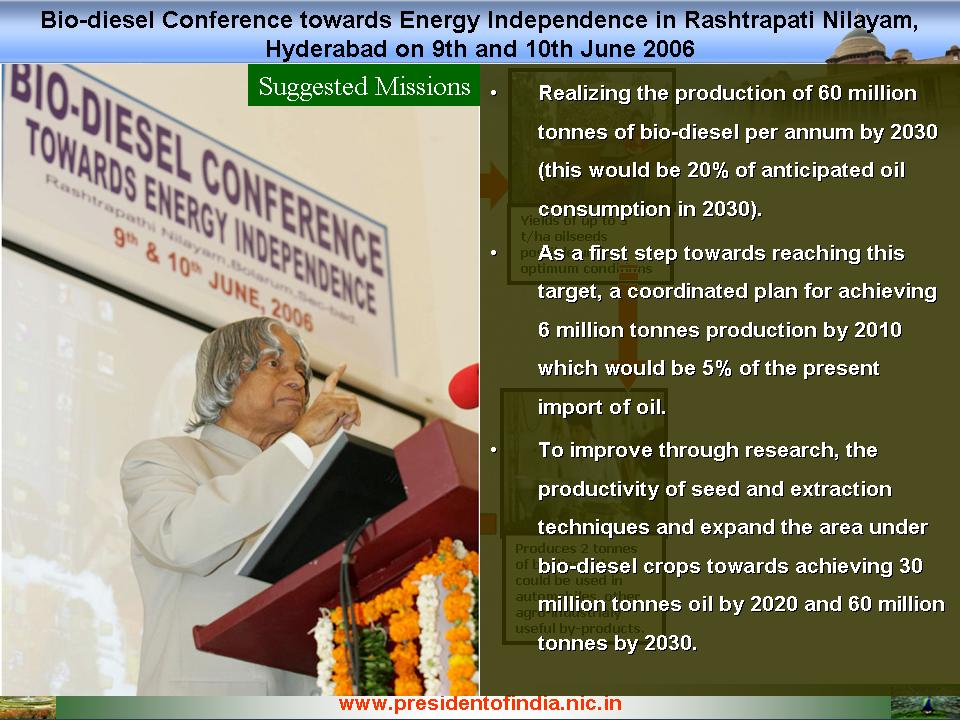

Suggested R&D Areas in Agriculture
Recently, I have addressed Global Forum on Agricultural Research (GFAR) ? triennial Conference 2006 on 9 Nov 2006 where the agriculture researchers from over 80 countries participated. There I have discussed certain R&D missions, which can be carried out collaboratively among different nations. This may be applicable to many of the participating organizations in this conference.
1. High yielding varieties
The productivity of the current varieties have reached a plateau. We have to develop high yielding varieties in addition to higher yield with more quality characteristics viz., more Vitamins and Minerals, which will help to reduce the nutritional dependent health problems. Eg. 1. Lack of ?Vitamin-A? in the food leads to Night blindness. To overcome this problem rice and other stable food must possess adequate quantity of vitamin A. Research in Genetically Modified plants such as Golden Rice Programme, needs to be hastened up.
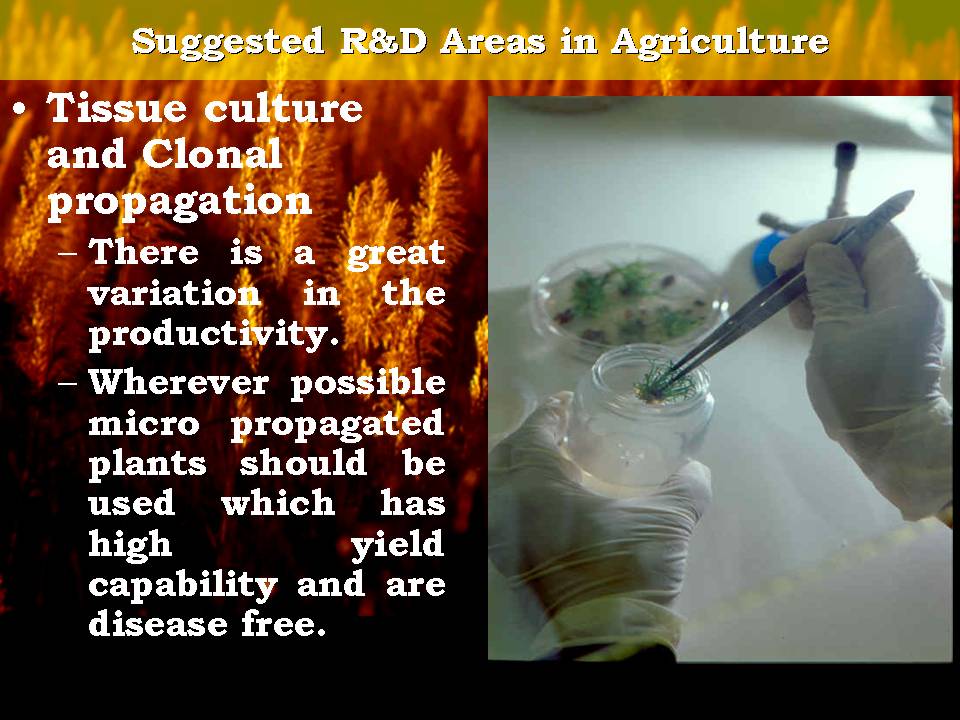
2. Tissue culture and Clonal propagation
There is a great variation in the productivity. Wherever possible micro propagated plants should be used which has high yield capability and are disease free.
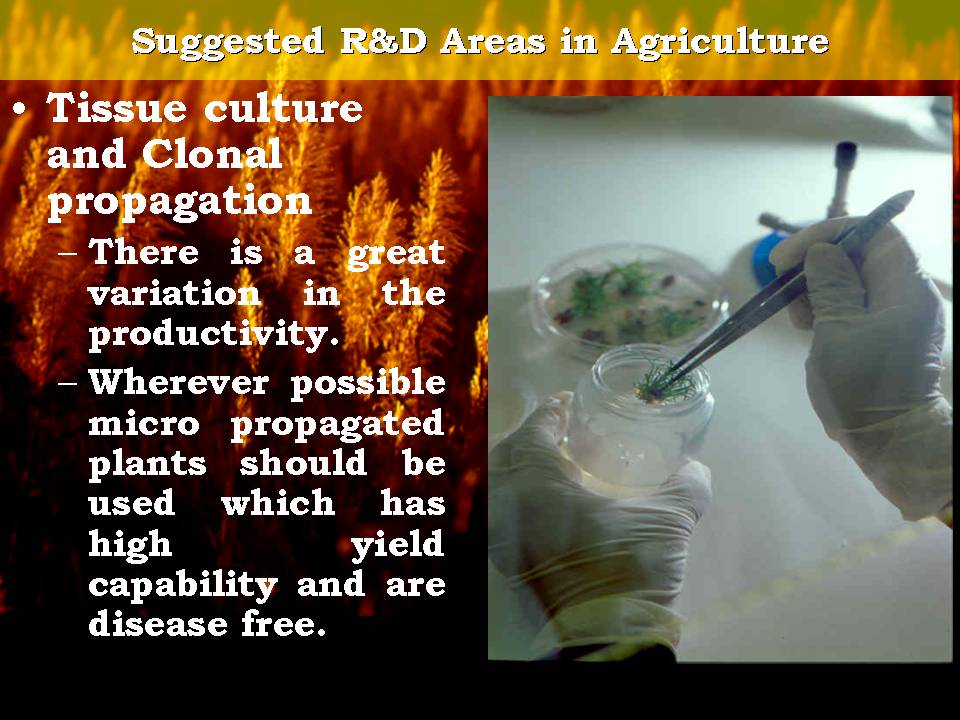
3. Global warming has resulted in increased CO2 % in the atmosphere. It favours C3 plants (Rice, wheat, etc.) breeding which has to be oriented towards enhanced yield by absorbing more CO2 in the atmosphere and increasing the yield.
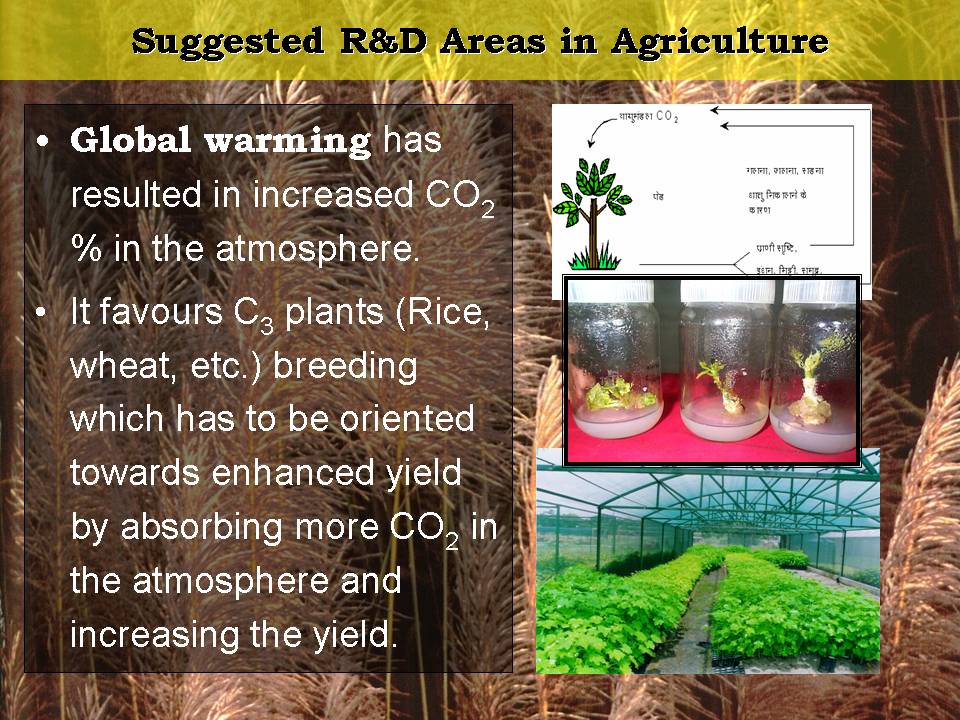
4. Radio-isotopes: R&D can be focused on using radio isotopes to diagnose nutritional deficiency in plants and soils for precise application of fertilizers. Also irradiation of seeds results high yield variety cereals.
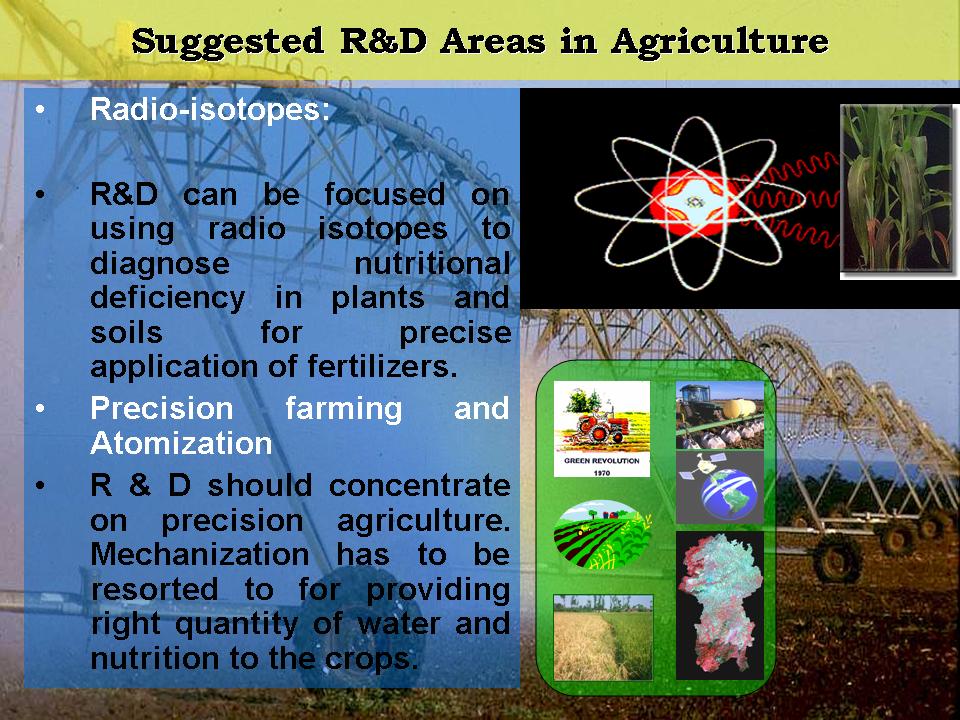
5. Precision farming and Automization
R & D should concentrate on precision agriculture. Mechanization has to be resorted to for providing right quantity of water and nutrition to the crops.
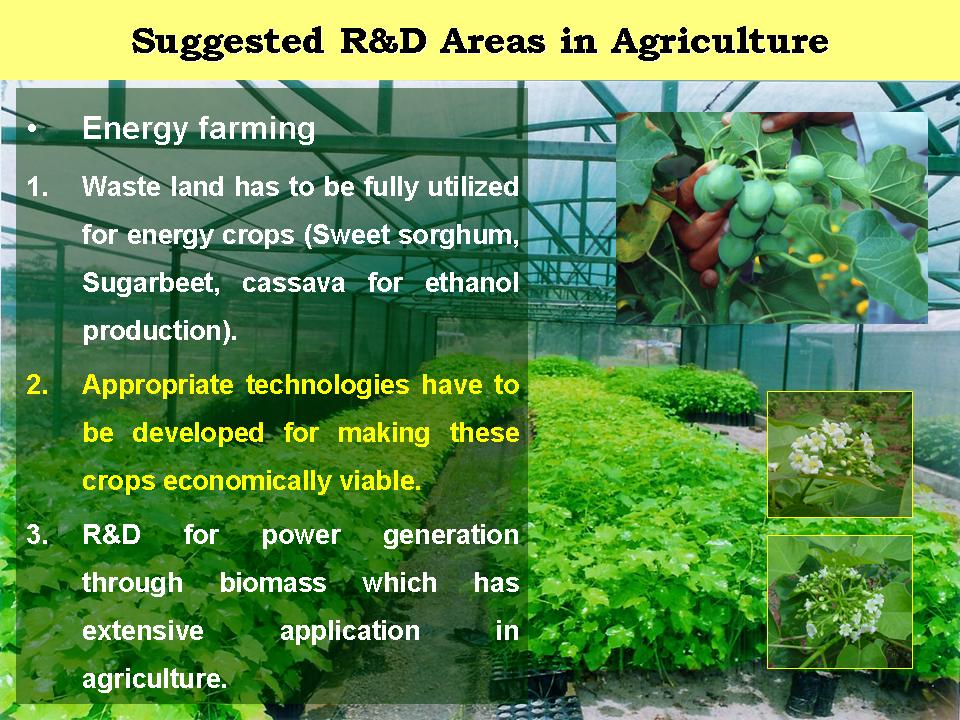
6. Energy farming
a. Waste land has to be fully utilized for energy crops (Sweet sorghum, Sugarbeet, cassava for ethanol production). Appropriate technologies have to be developed for making these crops economically viable.
b. R&D for power generation through biomass which has extensive application in agriculture.
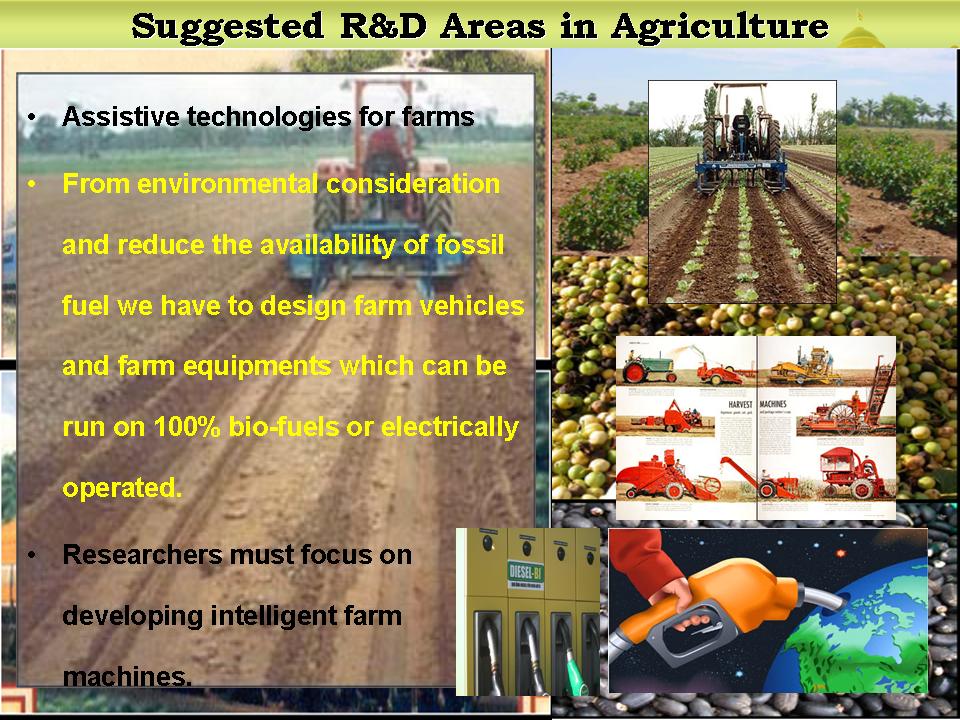
7. Assistive technologies for farms
From environmental consideration and reduce the availability of fossil fuel we have to design farm vehicles and farm equipments which can be run on 100% bio-fuels or electrically operated. Researchers must focus on developing intelligent farm machines. For example, a harvester should record the yield per unit area while harvesting. Intelligent mechanization like weeding only weeds and not the plants has to be developed.
Now I would like to discuss another important task for World Knowledge Platform, namely convergence of technologies.

Convergence of Technologies: Knowledge products
The information technology and communication technology have already converged leading to Information and Communication Technology (ICT). Information Technology combined with bio-technology has led to bio-informatics. Now, Nano-technology is knocking at our doors. It is the field of the future that will replace microelectronics and many fields with tremendous application potential in the areas of medicine, electronics and material science. When Nano technology and ICT meet, integrated silicon electronics, photonics are born and it can be said that material convergence will happen. With material convergence and biotechnology linked, a new science called Intelligent Bioscience will be born which would lead to a disease free, happy and more intelligent human habitat with longevity and high human capabilities. Convergence of bio-nano-info technologies can lead to the development of nano robots. Nano robots when they are injected into a patient, my expert friends say, it will diagnose and deliver the treatment exclusively in the affected area and then the nano-robot gets digested as it is a DNA based product. The convergence of technologies offers an opportunity for the design, development of knowledge products in the bio-info-nano technologies which will have an application in energy, agriculture and food processing, education and healthcare, ICT, infrastructure and critical technologies.
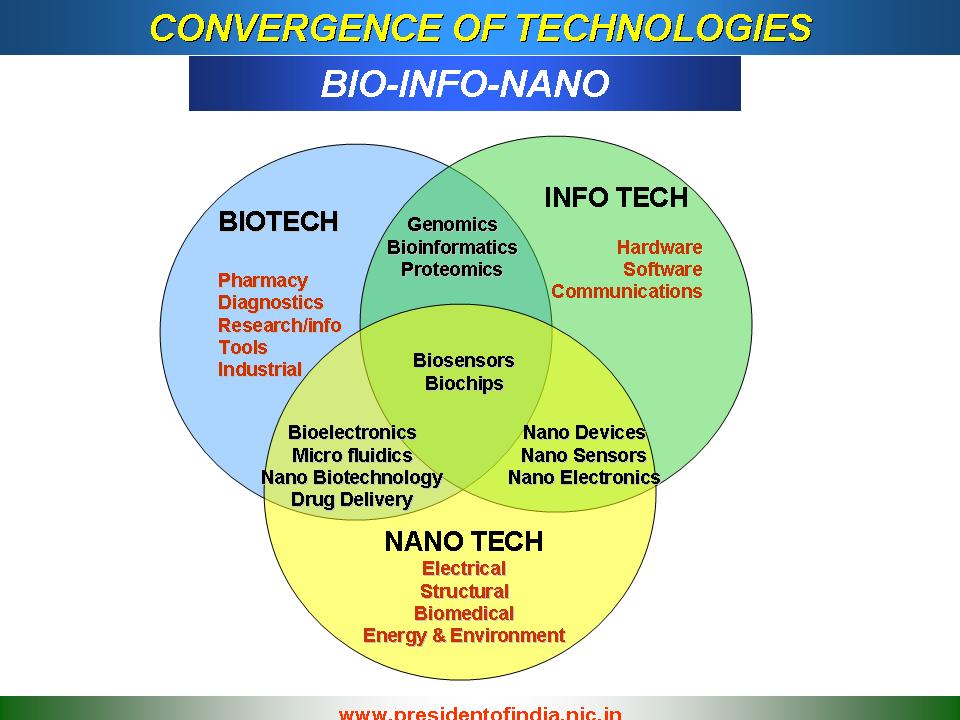
The proposed world knowledge platform will be the launch pad for many innovations that are waiting to be unearthed in these areas by the combined power of multiple nations for the benefit of humanity. The participants assembled here can work coherently in a mission mode to achieve faster realization of commercial availability of all the products just in time for the citizens in different parts of the world as it has already been done in the case of developing the state of the art super sonic cruise missile system called BrahMos.
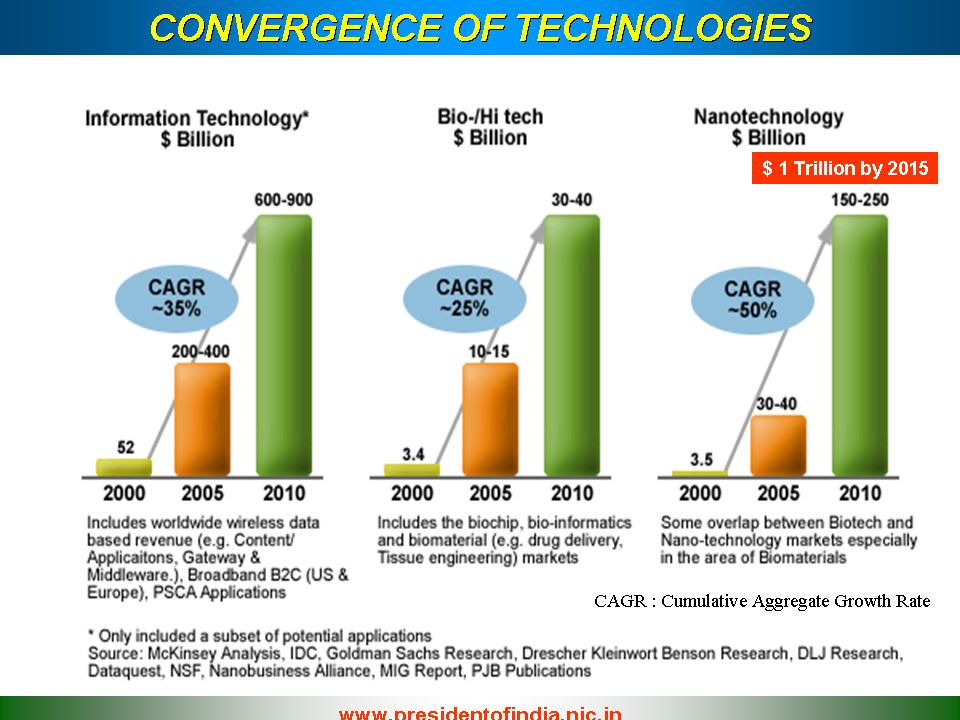

Conclusion
We have the natural resource, human resource and the core competence developed during the last two decades. Today, what we need is mobilizing and channelising these resources to produce products and systems just in time to meet the market demands. This can be achieved through Leaders who are central to the major change effort. Without strong and capable leadership from many people, restructuring, turnarounds and cultural changes do not happen well or at all. Also, there is a need to manage the process in change projects to keep the operation going out of control which needs sound leadership qualities. Hence, highly successful transformation efforts combine good leadership with good management. Such a combination I would call as creative leadership.
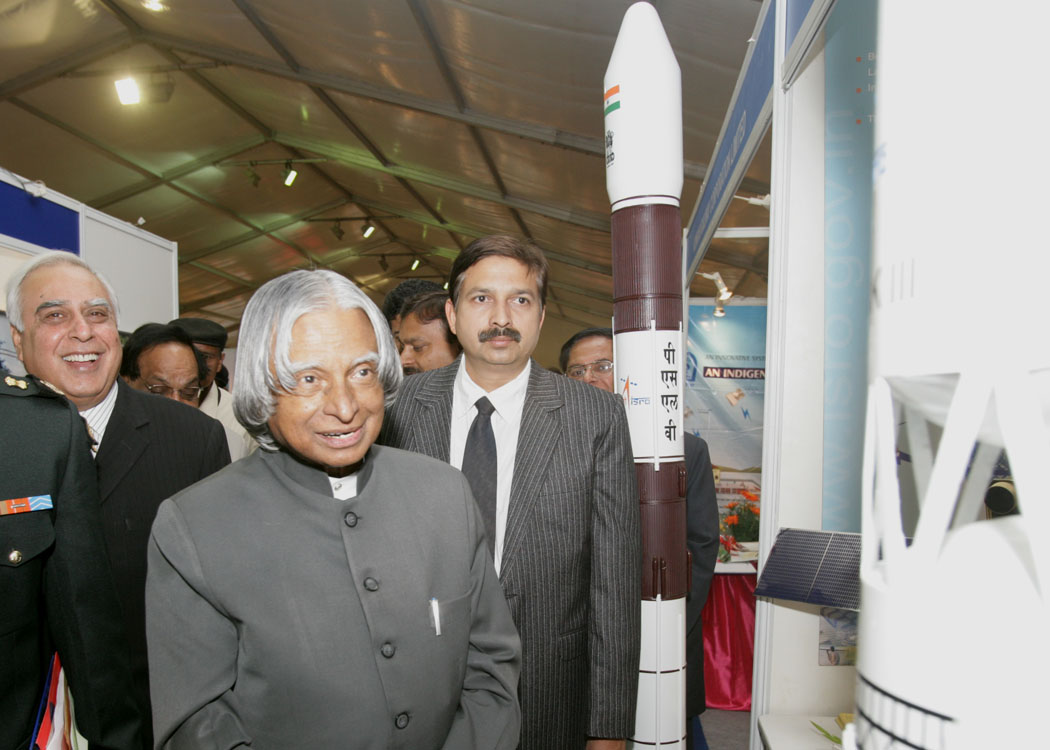
Creative leadership means exercising the vision to change the traditional role from the commander to the coach, manager to mentor, from director to delegator and from one who demands respect to one who facilitates self respect.
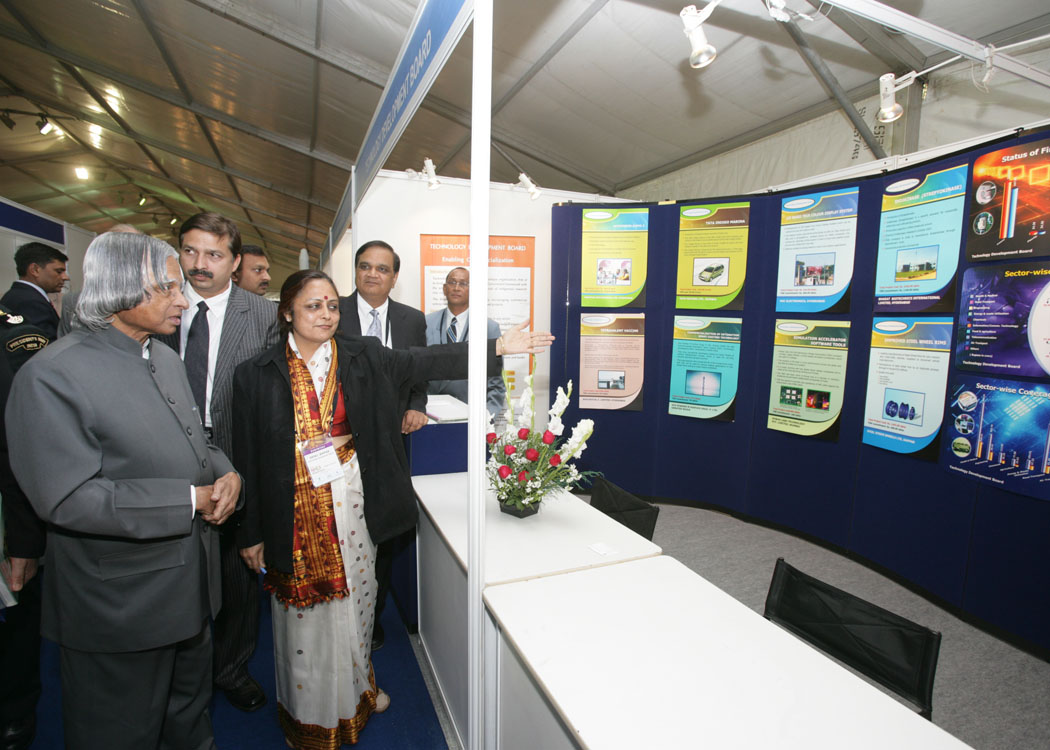
With these words, I inaugurate the Second International Conference-cum-Exhibition ?India R & D 2006: Mind Market?. My best wishes to all the participants? success in their mission of producing high quality products and systems at affordable cost and just in time while needed in the market through productive international partnership.
May God bless you.
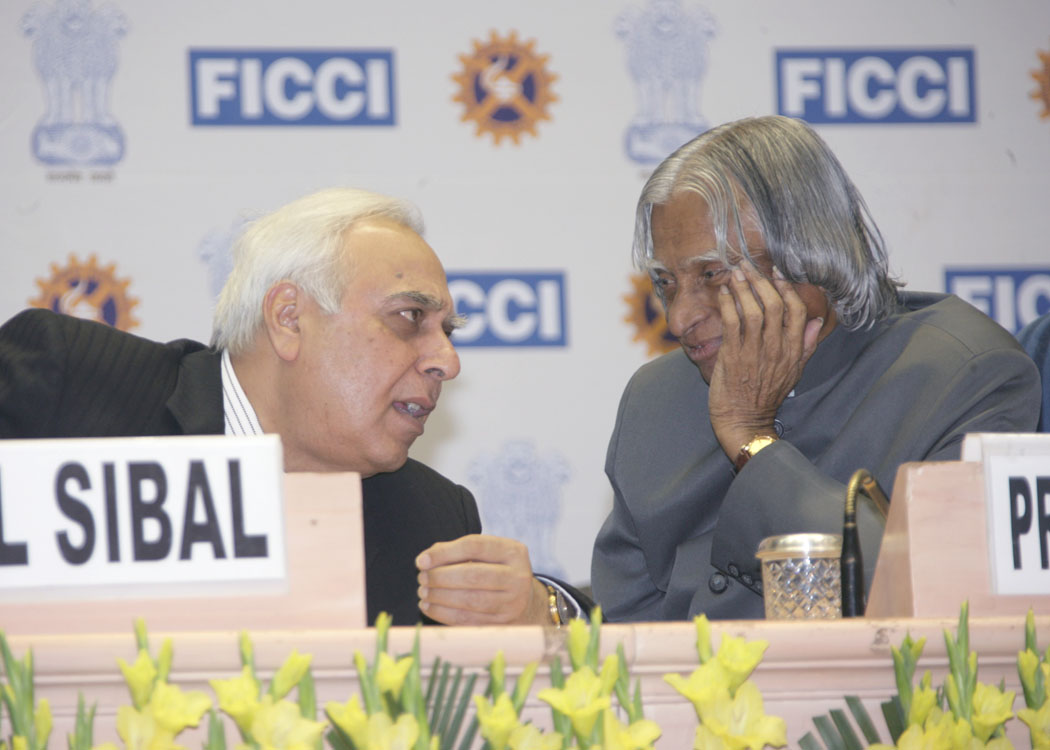
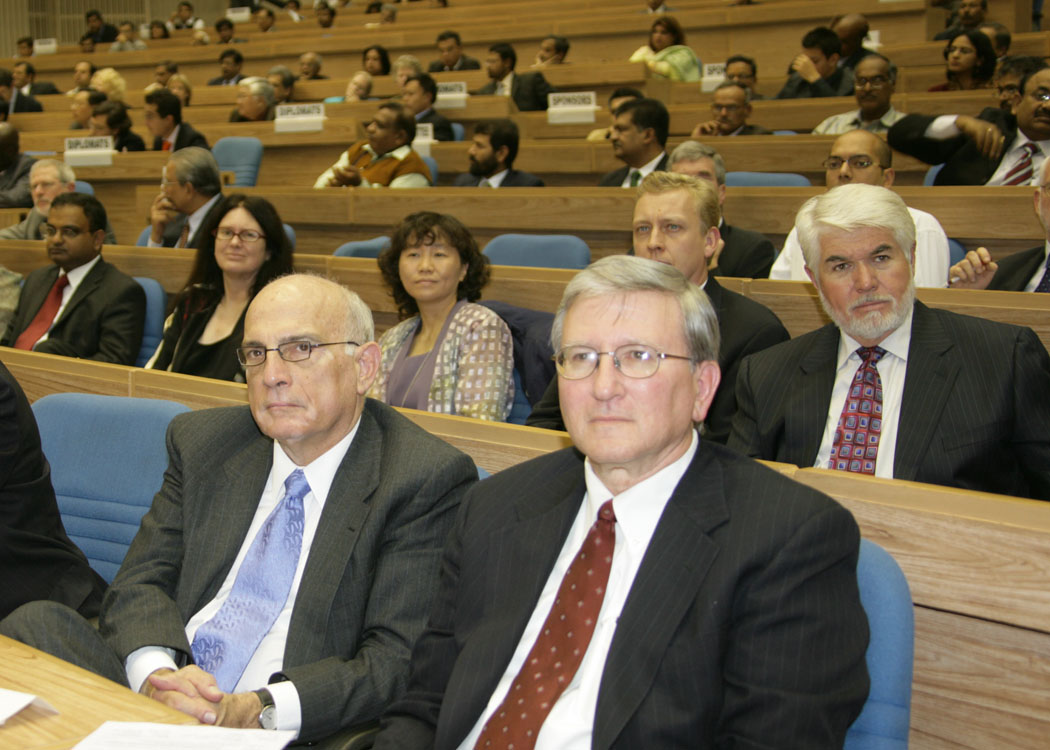
<<Back
|